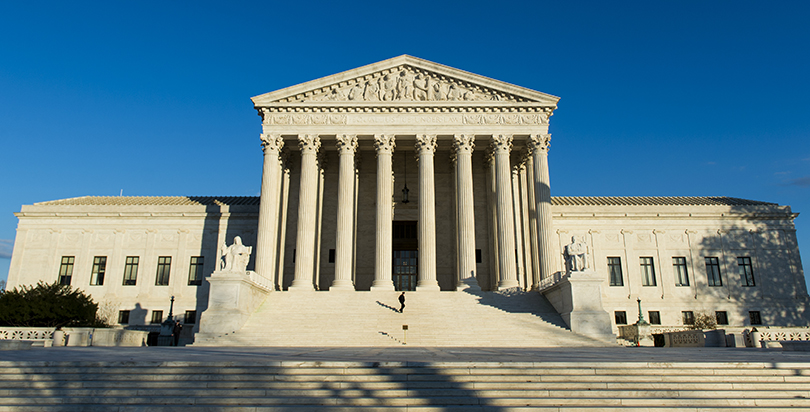Special Education at the Supreme Court: 7 Things to Know About Wednesday’s Endrew F. Case

Republicans in Washington will spend Wednesday charging full bore into the start of the new administration. President-elect Donald Trump is slated to give his first press conference since the election. The Senate will hold an hours-long series of votes related to repealing Obamacare. And at least four cabinet nominees will face their confirmation hearings — including Education Secretary–designate Betsy DeVos.
In a much slower, more deliberate but no less important event, the Supreme Court will hear oral arguments in Endrew F. v. Douglas County School District, which could alter the educational benefits guaranteed to the millions of American students with disabilities.
(The 74: Raw Supreme Court Transcript: The Justices Debate Special Education During the Endrew F. Case)
Since 1975, children with disabilities have been entitled to a “free, appropriate public education” under what’s currently called the Individuals with Disabilities Education Act (IDEA).
Justices in this case will decide what, if any, outcome is guaranteed to students with disabilities under that law — a “just above trivial” benefit, as is currently the standard in some parts of the country, or a “meaningful” one, as it in others. Setting a higher bar could prove costly for school districts — those that can’t show they’re meeting the standard must pay for children with disabilities to attend private school.
WATCH: Instant Expert — Understand the Endrew F. Case in 2 Minutes or Less:

Here are seven things to know ahead of oral arguments:
1. Who is Endrew, and what are the facts of the case?
Endrew F., also known as Drew, attended public school in Douglas County, Colorado, from preschool through fourth grade. He has autism, and under IDEA, he is entitled to a free, appropriate public education, with specific goals and plans laid out in what’s called an individualized education plan, agreed to by school leaders and his parents.
Beginning in second grade, his behavior began to deteriorate and teachers had to regularly remove him from the classroom after he would cry, yell and drop to the floor. Those behavioral problems interfered with his academic progress.
Endrew’s parents were dissatisfied with his progress in fourth grade and argued that his fifth-grade IEP was repetitive of previous years, so they enrolled him in a private school that specializes in treating children with autism. They later sought reimbursement from the district.
Under IDEA, if the public schools weren’t providing Drew with a free, appropriate public education as the law sets out, the district would have to pay for private school. The school district said Endrew made some educational progress, as required by law. State arbitrators and lower courts sided with the district.
2. What is the law currently?
The Supreme Court last considered the appropriate level of educational benefit for children with disabilities in 1982. In that case, known as Rowley, a girl who was hard of hearing was provided hearing aids, but not a sign language interpreter, during class. She was doing well, but not as well as she could have been doing. Justices ruled that IDEA requires “meaningful” access to a public education, but that doesn’t mean states must “maximize” the potential of children with disabilities. They also declined to set a single national test to determine if the education provided under IDEA is sufficient.
Judges in each of the 11 circuit courts across the country have set different standards. Two circuits have set a “meaningful educational benefit” standard. Five have decided on the “just above trivial” standard. Three others appear to side with the lower standard, one is split, and the final, for the District of Columbia, hasn’t considered the issue.
That split means that children in the Third Circuit, covering Pennsylvania, New Jersey and Delaware, are entitled to the “meaningful educational benefit” standard, while those to the south in Maryland, West Virginia and elsewhere in the Fourth Circuit are entitled only to “just above trivial” benefits.
In the executive branch, the Education Department has made special education a major push in the waning days of the Obama administration.
Guidance documents issued December 28 focus on the rights of students with disabilities in charter schools and the use of seclusion and restraint. The department has also called out racial disparities in special education and held a listening tour across Texas on the state’s reported use of an 8.5 percent cap on the number of students in each district who could be identified for special education services, a violation of federal law.
3. What are Endrew’s arguments?
Drew and his parents argue, in essence, that IDEA wasn’t written just to provide children with disabilities with access to public education, but to make that access meaningful.
Updates to IDEA after the Rowley decision further strengthened the law’s requirement that education for students with disabilities be meaningful, they argue.
In 1997, Congress required IEPs to contain measureable goals that are re-evaluated annually. In 2004, legislators aligned the IDEA standards to No Child Left Behind, requiring, with some exceptions, that students with disabilities take the same tests and be held to the same standards.
None of those objectives can be accomplished if the lower standard holds, Drew and his family argue. “Nor would it make any sense to establish high expectations for children with disabilities and to administer the same challenging assessments given to other students if all schools had to do was seek a merely more than de minimis educational benefit. Schools would be setting up children with disabilities to fail,” they added.
4. What are the school district’s arguments?
The district, meanwhile, argued that the question was already settled in Rowley — that IDEA doesn’t “prescribe the level of education to be accorded handicapped children.”
Other provisions in IDEA — the individualized education plan development process, the due process rights afforded children and parents, and monitoring by the U.S. Education Department — “help ensure that children will and do receive a high-quality education. There is no basis or need to second-guess Congress’s design,” attorneys for the district wrote.
Further, the district says, the higher standard is too vague and courts aren’t equipped to make those sorts of educational determinations.
5. Who has sided with Endrew, and what do they say?
Much of the U.S. government is on Endrew’s side.
More than 100 current and former Democratic members of Congress argue in a brief that the district’s interpretation, which they call a “vanishingly low standard,” runs contrary to legislators’ intent in writing the original law and updating it in the ensuing decades. “Congress did not expend the time and effort to create a legislative scheme — and then repeatedly refine that scheme over a thirty-year period — to accomplish next to nothing,” the brief said.
The U.S. government, through the solicitor general’s office, also sides with Endrew and, like federal lawmakers, argues that a lower standard doesn’t square with Congress’s intent.
“It is hard to imagine a legal standard that more directly contradicts Congress’s purpose of embracing ‘high expectations’ and rejecting ‘low expectations’ than one that requires school to provide educational benefits that are ‘merely more than de minimus,’ ” the government wrote.
The court’s previous decision in Rowley, requiring “meaningful access” to special education, is most reasonably interpreted to mean that children with disabilities must have a chance to make meaningful progress, the government said. The brief also rejected the idea that a higher standard would be a “license for courts to micromanage the reasonable judgments of educators or state hearing officers.”
Ten briefs in total support Endrew, including ones from the National Education Association; charter schools; the states of Delaware, Massachusetts and New Mexico; and numerous disability advocacy groups.
6. And who’s siding with the school district? What are their arguments?
Three briefs have been filed on behalf of the school district.
One, from the Council of Great City Schools, which represents the country’s 70 largest urban school systems, says courts aren’t equipped to second-guess educational decisions made through the IEP process. Setting a higher standard would raise costs, both from additional litigation and more private school placements, which the group says cost five times what it would cost to provide similar services within the district.
Those greater costs come at a time of decreased education funding, the Council stated. And Congress has never provided sufficient money for IDEA. By law, the federal government is supposed to cover 40 percent of the additional cost of educating students with disabilities, but it has never done so. The federal government spends about $11.5 billion every year on grants to states for K-12.
“If Congress wishes to change the definition of [free, appropriate public education] in a way that dramatically increases the cost of special education, it will face significant public pressure to raise federal funding levels as well. Similarly, the Court, without the ability to increase such funding, should not adopt a costly definitional change that Congress has not,” the Council added.
Another supportive brief comes from a coalition of school administrator groups, including those representing superintendents, principals, business officials, rural schools and others. They argue that the “some benefit” standard is working with the goals of IDEA and that if a change to the standard is made, Congress should be the ones to make it.
7. Is there any indication this will result in a 4–4 tie? Would a new justice appointed by President-elect Trump affect the outcome?
The justices’ decision to hear the case and schedule oral arguments before a new justice will be appointed is an indication that there are enough votes one way or the other to avoid a tie with the present court makeup.
Justices don’t participate in decisions if they didn’t attend oral arguments, so there’s no reason to believe the court is waiting on confirmation of a ninth member to break a tie before releasing a decision in Endrew. That’s a contrast to its delays in scheduling arguments in more controversial cases, like the one concerning transgender students’ access to bathrooms and other school facilities that fit with their gender identity.
Get stories like these delivered straight to your inbox. Sign up for The 74 Newsletter

;)
